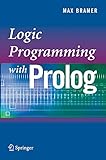Logic Programming with Prolog / by Max Bramer.
Tipo de material: TextoEditor: London : Springer London, 2005Descripción: xiv, 223 páginas recurso en líneaTipo de contenido:
TextoEditor: London : Springer London, 2005Descripción: xiv, 223 páginas recurso en líneaTipo de contenido: - texto
- computadora
- recurso en línea
- 9781846282126
- QA76.7-76.73
Springer eBooks
Getting Started -- Clauses and Predicates -- Satisfying Goals -- Operators and Arithmetic -- Input and Output -- Loops -- Preventing Backtracking -- Changing the Prolog Database -- List Processing -- String Processing -- More Advanced Features.
Logic Programming is the name given to a distinctive style of programming, very different from that of conventional programming languages such as C++ and Java. By far the most widely used Logic Programming language is Prolog. Prolog is a good choice for developing complex applications, especially in the field of Artificial Intelligence. This book does not assume that the reader is an experienced programmer or has a background in Mathematics, Logic or Artificial Intelligence. It starts from scratch and aims to arrive at the point where quite powerful programs can be written in the language. It is intended both as a textbook for an introductory course and as a self-study book. On completion the reader will know enough to use Prolog in their own research or practical projects. Each chapter has self-assessment exercises so that the reader may check their own progress. A glossary of the technical terms used completes the book. Max Bramer is the Digital Professor of Information Technology at the University of Portsmouth, England. He has taught Prolog to undergraduate computer science students and used Prolog in his own work for many years.
Para consulta fuera de la UANL se requiere clave de acceso remoto.


